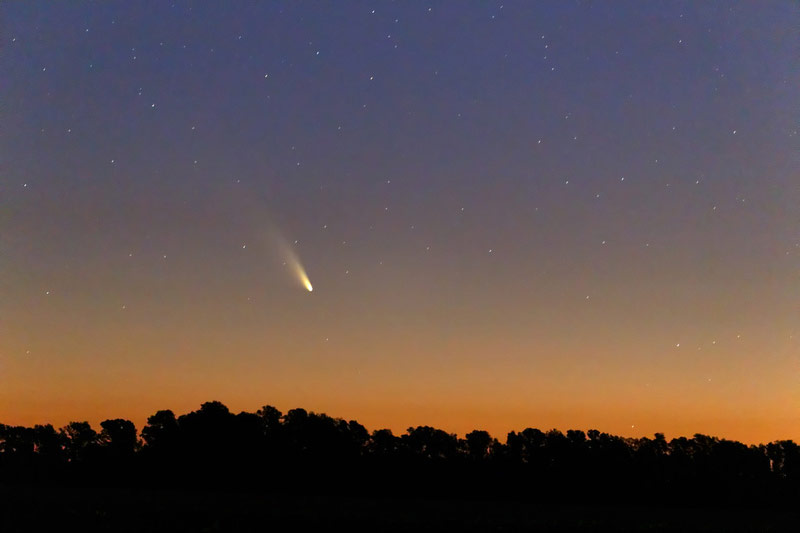
The Comet Pan-STARRS has brightened dramatically over this past week, putting it back on back on track for a potentially spectacular night sky display this month.
The comet is now seemingly very close to early predictions of its brightness in the March sky, and it could conceivably be as bright as, or brighter, than a first-magnitude star when it makes its closest approach to the sun (called perihelion) on Sunday (March 10). That would make it clearly visible to the naked eye.
Comet Pan-STARRS, known officially as comet C/2011 L4 (PANSTARRS), was discovered in June 2011 by astronomers using the Panoramic Survey Telescope & Rapid Response System, or Pan-STARRS telescope, in Hawaii. It is passing through the inner solar system this month and makes its closest approach to Earth on Tuesday (March 5), when it will be within 100 million miles (160 million kilometers) of Earth.
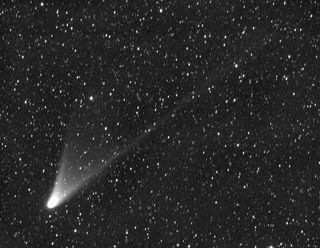
But the comet's brightness this month was in question because it was not meeting expectations earlier in the year.
Astronomers measure the brightness of objects on a scale of magnitude in which the objects with the smallest number magnitude are actually the brightest. Objects with negative number magnitudes are exceptionally bright. The unaided eye can detect night sky objects as dim as a magnitude +6 on the scale. [Photos of Comet Pan-STARRS by Stargazers]
In January, the comet was lagging as much as 1.5 magnitudes fainter than predicted — which would have made the comet appear only one-quarter as bright as expected. And this pattern showed little change into the first half of February. This was not completely unexpected, since the comet is apparently a "new" comet, making its very first approach to the sun and such first-timers usually do not brighten as well as initial forecasts suggest.
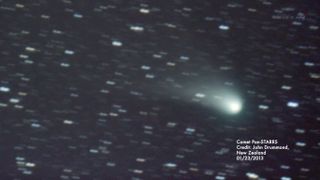
Get the Space.com Newsletter
Breaking space news, the latest updates on rocket launches, skywatching events and more!
Comet's sudden surge
While C/2011 L4 (PANSTARRS) appeared to be on a fading track, in the last week the comet has put on a sudden surge in brightness, getting noticeably brighter each day. Observers in the Southern Hemisphere, where the comet has been exclusively visible since its discovery have commented in recent days of how much more impressive the comet now looks against the evening twilight sky.
When looking through binoculars or small wide-field telescopes, some Australian observers have likened Comet Pan-STARRS to a "miniature Comet Bennett." (Bennett was an impressive zero-magnitude comet with a distinctive dust tail that was visible in the predawn skies of late March and April 1970.)
The most recent estimates place Comet Pan-STARRS somewhat fainter than the bright star Fomalhaut — probably on the order of magnitude +1.5. This is amazing, considering that only a week or two ago, it appeared that the comet might not get much brighter than magnitude +2 or even +3. [Amazing Night Sky Sights of March (Video)]
The latter figure would have made the comet no brighter than Megrez, the star that joins the handle to the bowl of the Big Dipper and is the dimmest of the Dipper's seven stars.
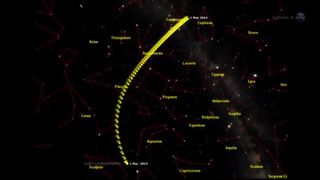
So how much brighter can the comet get?
According to the well-known comet expert John E. Bortle: "Pan-STARRS has behaved so strangely up to this point that I would not completely discount anything; with perihelion passage so close now, I am anticipating the maximum brightness reached by the comet as between +1 and +1.3."
"This, of course, does not negate an outside possibility of the comet perhaps continuing to brighten for some days past perihelion," Bortle said.
The only real drawback so far as the comet's overall appearance is concerned is that the dust tail appears to be bright, albeit rather short and stubby. It extends only 2 or 3 degrees from the comet's nucleus when viewed through binoculars (your clenched fist held at arm's length is equal to roughly 10 degrees).
This is probably due to trying to view Pan-STARRS against a bright twilight background. To some, using just their eyes, the comet might look like it doesn't have a tail at all. "As it is, even through photographic imaging hardly anyone can trace the dust tail more than about 3 degrees, which is disappointing," Bortle said.
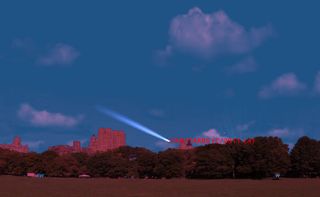
Northern Hemisphere's turn
The comet should begin to finally become visible to Northern Hemisphere skywatchers on Thursday (March 7), weather permitting, when it will rise very low near the west-southwest horizon about a half hour after sunset.
Next Tuesday (March 12), the comet will stand almost directly above the western horizon, less than 5 degrees to the left of a very narrow crescent moon. The comet will continue to slowly get higher and shift slowly toward the west-northwest part of the sky during the middle and later part of March, also becoming gradually dimmer as it pulls away from both the sun and the Earth.
Any tail that may be present should appear to be pointed straight up and tipped to the left through mid-March, then for the remainder of the month be tipped a bit more to the right.
Editor's note: If you snap an amazing photo of Comet Pan-STARRS in the night sky, or any other celestial object, and you'd like to share for a possible story or image gallery, please send images and comments, including location information, to managing editor Tariq Malik at spacephotos@space.com.
This story was updated at 7:22 a.m. ET on March 5 to correct the spelling of the name of comet expert John E. Bortle.
Joe Rao serves as an instructor and guest lecturer at New York's Hayden Planetarium. He writes about astronomy for The New York Times and other publications, and he is also an on-camera meteorologist for News 12 Westchester, New York. This article was first published on SPACE.com.
Join our Space Forums to keep talking space on the latest missions, night sky and more! And if you have a news tip, correction or comment, let us know at: community@space.com.

Joe Rao is Space.com's skywatching columnist, as well as a veteran meteorologist and eclipse chaser who also serves as an instructor and guest lecturer at New York's Hayden Planetarium. He writes about astronomy for Natural History magazine, Sky & Telescope and other publications. Joe is an 8-time Emmy-nominated meteorologist who served the Putnam Valley region of New York for over 21 years. You can find him on Twitter and YouTube tracking lunar and solar eclipses, meteor showers and more. To find out Joe's latest project, visit him on Twitter.










